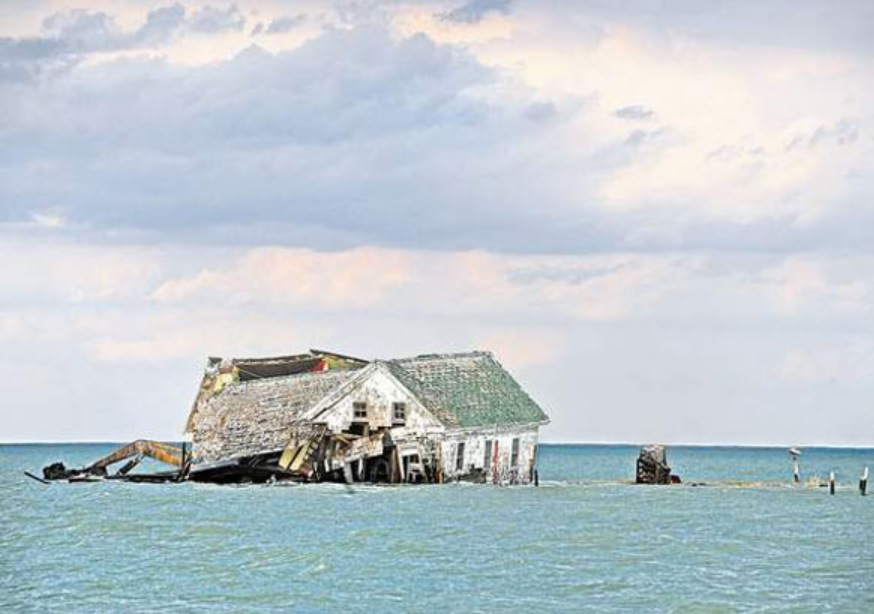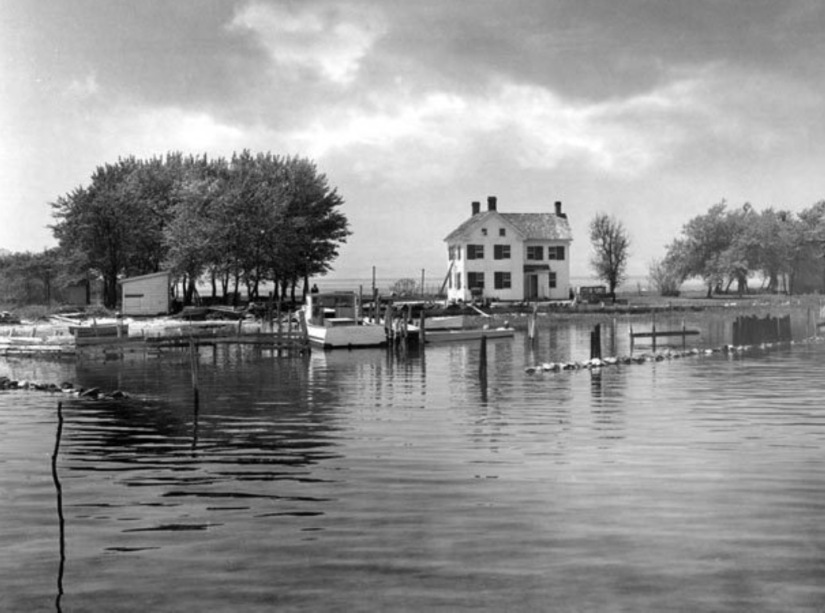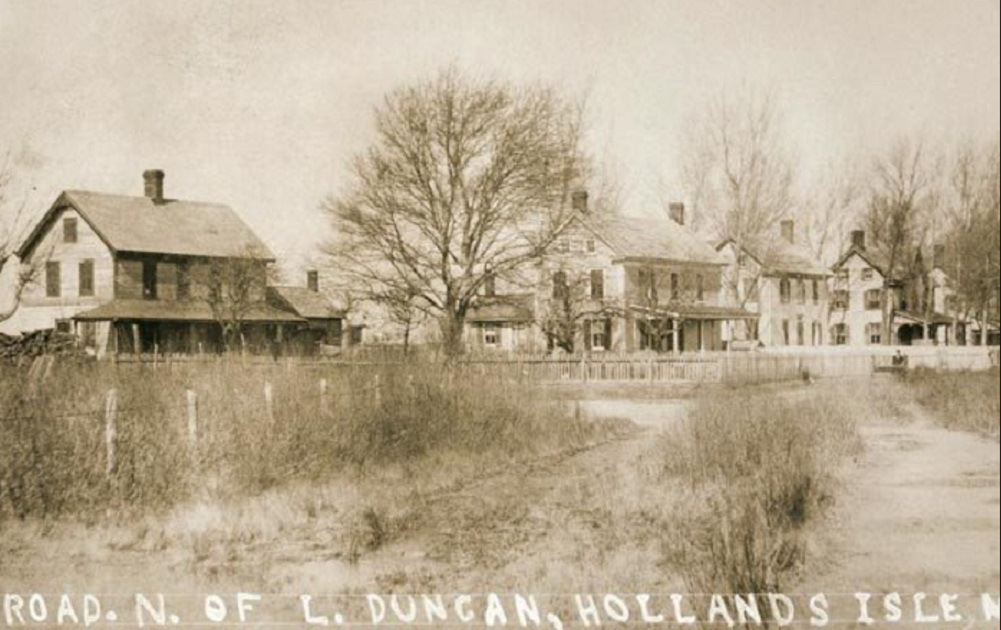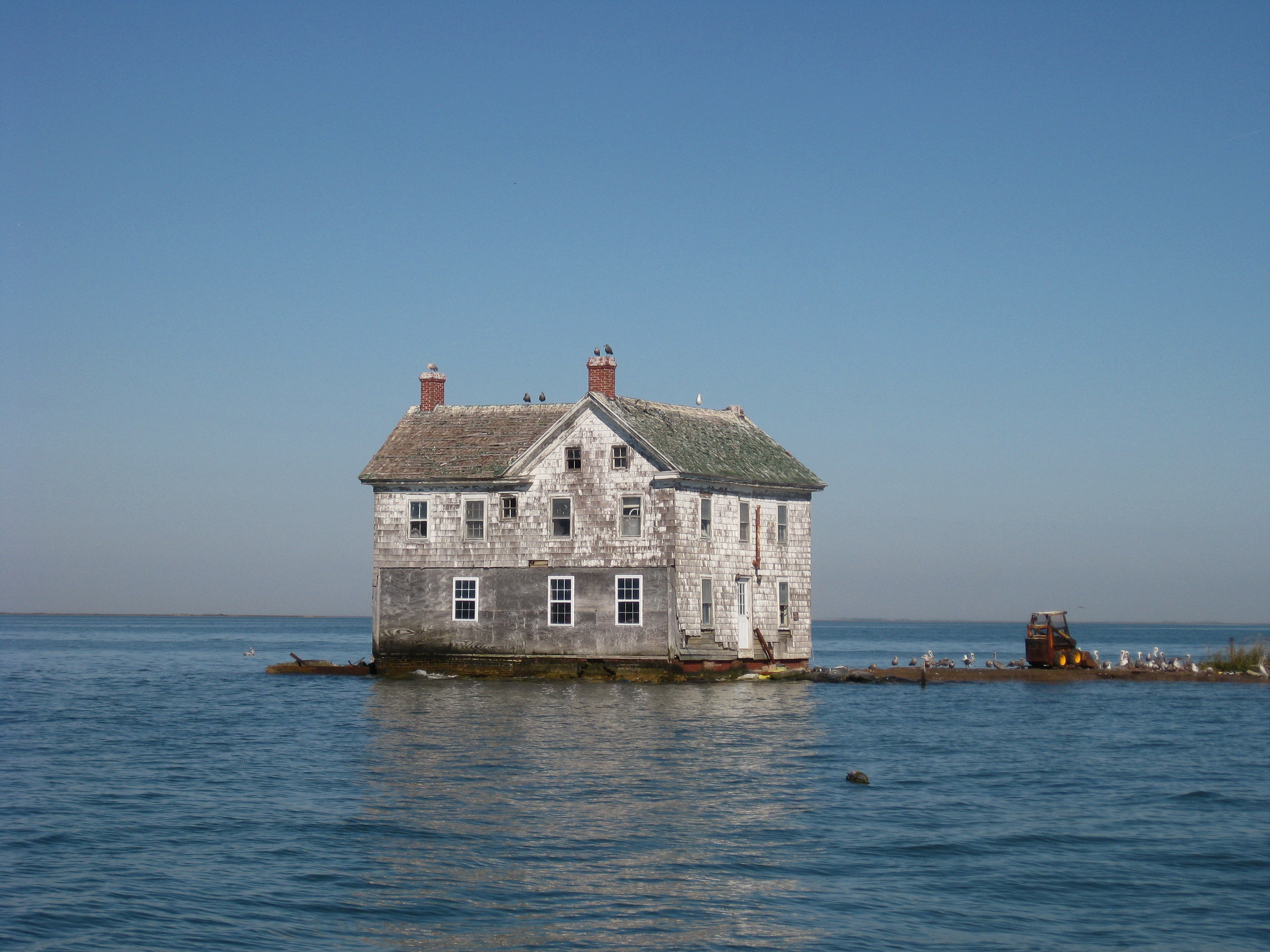While doing research for my historical fiction series, Tapestry of Love, which is set in the 17th century on the Eastern Shore of Virginia and Maryland, I discovered a considerable amount of history occurred on the off shore islands of Virginia and Maryland. I am saddened to see that today, many of these islands are gradually disappearing into the ocean. See stories in Newsweek – Smith Island Is Sinking Into the Chesapeake Bay Thanks to Climate Change and That Sinking Feeling
The last house on Holland Island in October 2009 – Built in 1888, this Victorian home from a different era has braved the elements and fought shoreline erosion on Holland Island in Chesapeake Bay for well over a century. It fell into the bay in October 2010 and is no longer visible. (Wikipedia)
 Oldest house fell into the bay in October 2010 (Sometimes interesting.com)
Oldest house fell into the bay in October 2010 (Sometimes interesting.com)
 Holland Island on October 18, 1953 (Sometimes interesting.com)
Holland Island on October 18, 1953 (Sometimes interesting.com)
Holland Island was once a marshy, island in the Chesapeake Bay in Dorchester County, Maryland, west of Salisbury,USA, located in the Holland Strait, between Bloodsworth Island and Smith Island, six miles west of Wenona, Maryland.
Originally, settled in the 1600s, the island was inhabited by watermen and farmers. Its name comes from Daniel Holland, the original purchaser of the property. In 1850, a community of fishing and farming families lived on the island, and by 1910, the island had 360 residents with 70 homes, stores and other buildings. It also had its own post office, two-room school with two teachers, a church, baseball team, community center, and a doctor. The islanders supported themselves mainly by dredging for oysters, fishing for shad and crabbing.
 Earlier Days of Holland Island (Sometimes interesting.com)
Earlier Days of Holland Island (Sometimes interesting.com)
However, the wind and tide began to erode the west side of the island where most of the houses were located in 1914 and the residents were force to move to the mainland. “Many disassembled their houses and other structures and took them to the mainland, predominantly Crisfield. Attempts to protect the island by building stone walls were unsuccessful. The last family left the island in 1918, when a tropical storm damaged the island’s church. A few of the former residents continued living on the island during the fishing season until 1922, when the church was moved to Fairmount, Maryland.”
The island’s size has been reduced by half, from 160 acres in 1915 to 80 acres in 2005.
Another island closeby is following the same pattern. Smith Island, Virginia is gradually disappearing in the Chesapeake Bay at a fast clip. The island has been shrinking in size for centuries, due to a combination of its low elevation and storm erosion.
Smith Island is the only remaining inhabited offshore island group and was charted by Captain John Smith as early as 1608 as “The Russell Isles.” The island residents are one of the region’s oldest English-speaking communities, which is known for its relic accent, preserving speech patterns from the original English colonial settlers. “The island was first settled between 1659 and 1686 by English and Welsh settlers, to whom today’s inhabitants can trace their genealogy going back twelve generations.
Smith Island is on the border of Maryland and Virginia territorial waters in the United States. The island has been shrinking in size for centuries, due to a combination of its low elevation and storm erosion.
Smith Island is the only remaining inhabited offshore island group and was charted by Captain John Smith as early as 1608 as “The Russell Isles.” The island is inhabited by one of the region’s oldest English-speaking communities, which is known for its relic accent, preserving speech patterns from the original English colonial settlers. It was settled between 1659 and 1686 by English and Welsh settlers, to whom today’s inhabitants can trace their genealogy going back twelve generations.
Many historic books about the settlers of Virginia mention Smith island by name. The New Encyclopædia; or, Universal Dictionary of Arts and Sciences written in 1807 by Encyclopaedia Perthensis states the following: Smith’s Island, an island on the coast of Virginia, the Southermost (sic) of the range, that lies along the coast of Northampton and Accomack Counties.
Smith Island is actually part of a group of islands named Smith’s Isles off the coast of Accomack and Northampton counties in Virginia. The same book above states: Smith’s Isles, a range of islands on the coast of Accomack and Northampton counties, in Virginia, so named from Captain John Smith, who, in 1608, landed on the peninsula, and was kindly received by Accomack, the native prince of the peninsula, part of which still bears his name.
Though claimed to be named after John Smith in this book, Smith’s Island is actually named after Henry Smith, an early land owner.
Because of its strategic location near the mouth of the Chesapeake Bay, the Island has had many famous visitors, besides John Smith over the years. Some of theses include:
- Custis Family – family of President George Washington’s wife Mary Custis owned Smith Island since 1691 when it was granted to John Custis.
- Blackbeard the pirate – used the south end of the island for a layover during the days of his piracy on the Atlantic.
- Confederate General Robert E. Lee – who visited Smith’s Island in 1832. He had recently married into the great-granddaughter of George Washington’s wife. “In his 1832 visit, Lee had found Smith Island to be “nearer the level of the sea than I expected to find it”. He describes the surface of the island as being “composed of alternate ridges and glades running as near as I could judge from north to south and from one extremity to the other”. He found “the soil of the glades is as rich as possible and covered with fine grass, that of the ridges contains a great deal of sand and is covered with pine”. Barrier island migration, or erosion, was a problem for island owners even in 1832, as Lee describes in a letter dated may 22, 1832, the part of the island exposed to the ocean as “wearing away, the beach which used to protect the glades has been in many places levelled, and the water at common high tide finds its way into the glades and renders the pasturage not so good”.
- Smith Island remained in the Custis-Lee families until 1911.
- Joshua Thomas – famed Methodist Evangelist who held the first camp meeting on the island.



